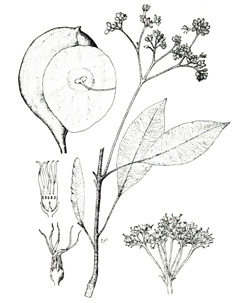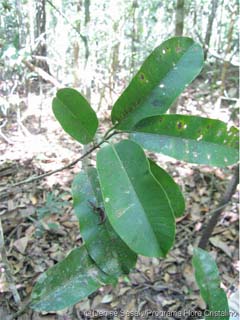 |
|
https://edibleplants.org/ |
 |
| (c)Projeto Flora Cristalino |
Translate this page:
Summary
Aspidosperma album is a 10-30 m tall evergreen tree with a 30-60 cm bole diameter. It is commonly harvested from the wild for medicinal purposes and high class timber called Araracanga. The bark has antifungal properties. It is used as an astringent and to reduce fever. Diarrhoea, fevers, and malaria can be treated also by using bark decoction. For dermatosis, juice from the macerated inner bark can be applied to affected areas. The wood of A. album is used for heavy construction. It is resistant to fungi, dry wood borers, and termites.
Physical Characteristics

 Aspidosperma album is an evergreen Tree growing to 25 m (82ft) by 18 m (59ft) at a medium rate.
Aspidosperma album is an evergreen Tree growing to 25 m (82ft) by 18 m (59ft) at a medium rate.
See above for USDA hardiness. It is hardy to UK zone 10. The flowers are pollinated by Insects.
Suitable for: light (sandy), medium (loamy) and heavy (clay) soils and prefers well-drained soil. Suitable pH: mildly acid, neutral and basic (mildly alkaline) soils. It cannot grow in the shade. It prefers moist soil and can tolerate drought. The plant is not wind tolerant.
UK Hardiness Map
US Hardiness Map
Synonyms
Aspidosperma centrale Markgr. Aspidosperma latisiliqua (Poir.) A.DC. Bignonia latisiliqua Poir. Maca
Plant Habitats
Edible Uses
References More on Edible Uses
Medicinal Uses
Plants For A Future can not take any responsibility for any adverse effects from the use of plants. Always seek advice from a professional before using a plant medicinally.
Antidiarrhoeal Antifungal Astringent Febrifuge Febrifuge Malaria Skin
The bark is antifungal, astringent, febrifuge[348. A decoction is used in the treatment of diarrhoea, fevers and malaria[ 348 ]. Juice from the macerated inner bark is applied to affected area as a treatment for dermatosis[ 348 ].
References More on Medicinal Uses
The Bookshop: Edible Plant Books
Our Latest books on Perennial Plants For Food Forests and Permaculture Gardens in paperback or digital formats.

Edible Tropical Plants
Food Forest Plants for Hotter Conditions: 250+ Plants For Tropical Food Forests & Permaculture Gardens.
More

Edible Temperate Plants
Plants for Your Food Forest: 500 Plants for Temperate Food Forests & Permaculture Gardens.
More

More Books
PFAF have eight books available in paperback and digital formats. Browse the shop for more information.
Shop Now
Other Uses
Furniture Wood
Other uses rating: High (4/5). Other Uses The orange-brown wood has a waxy feeling[ 46 ]. It is used for heavy construction[ 46 ], and is recommended for high class end uses in cabinet making etc[ 848 ]. This tree yields a timber known as 'araracanga'. We do not have any more specific information, but a general description of araracanga is as follows:- The heartwood is vermillion or deep reddish brown, sometimes with large pink veins, and constitutes about two-thirds of the bole; it is clearly demarcated from the 3 - 8cm wide band of almost white to light brown sapwood[ 409 ]. The texture is medium; the grain straight or interlocked. The wood is very heavy, very hard and very durable when in contact with the soil, being very resisant to fungi and dry wood borers, and moderately resistant to termites. It is somewhay slow to season, with a high risk of checking and distortion; once dry it is poorly stable in service. It has a fairly high blunting effect and is hard to work - power tools that are stellite-tipped and tungsten carbide are recommended; nailing and screwing are good, but pre-boring is required; gluing is correct for interior purposes only. The wood has various applications, being used for purposes such as heavy bridges, railroad ties, house posts, heavy carpentry, industrial flooring, hydraulic works in fresh water etc[ 848 ].
Special Uses
References More on Other Uses
Cultivation details
A very variable species, especially in leaf form[ 409 ]. This is possibly as a result of hybridisation with other members of the genus, possibly A. Spruceanum or A. Fendleri[ 409 ].
References Carbon Farming Information and Carbon Sequestration Information
Temperature Converter
Type a value in the Celsius field to convert the value to Fahrenheit:
Fahrenheit:
The PFAF Bookshop
Plants For A Future have a number of books available in paperback and digital form. Book titles include Edible Plants, Edible Perennials, Edible Trees,Edible Shrubs, Woodland Gardening, and Temperate Food Forest Plants. Our new book is Food Forest Plants For Hotter Conditions (Tropical and Sub-Tropical).
Shop Now
Plant Propagation
Seed
Other Names
If available other names are mentioned here
Guatambœ
Native Range
Coming Soon
Weed Potential
Right plant wrong place. We are currently updating this section.
Please note that a plant may be invasive in one area but may not in your area so it's worth checking.
None Known
Conservation Status
IUCN Red List of Threatened Plants Status : This taxon has not yet been assessed.

Growth: S = slow M = medium F = fast. Soil: L = light (sandy) M = medium H = heavy (clay). pH: A = acid N = neutral B = basic (alkaline). Shade: F = full shade S = semi-shade N = no shade. Moisture: D = dry M = Moist We = wet Wa = water.
Now available:
Food Forest Plants for Mediterranean Conditions
350+ Perennial Plants For Mediterranean and Drier Food Forests and Permaculture Gardens.
[Paperback and eBook]
This is the third in Plants For A Future's series of plant guides for food forests tailored to
specific climate zones. Following volumes on temperate and tropical ecosystems, this book focuses
on species suited to Mediterranean conditions—regions with hot, dry summers and cool, wet winters,
often facing the added challenge of climate change.
Read More
Expert comment
Author
(Vahl) Benoist ex Pichon
Botanical References
Links / References
For a list of references used on this page please go here
A special thanks to Ken Fern for some of the information used on this page.
Readers comment
| Add a comment |
|
If you have important information about this plant that may help other users please add a comment or link below. Only comments or links that are felt to be directly relevant to a plant will be included. If you think a comment/link or information contained on this page is inaccurate or misleading we would welcome your feedback at [email protected]. If you have questions about a plant please use the Forum on this website as we do not have the resources to answer questions ourselves.
* Please note: the comments by website users are not necessarily those held by PFAF and may give misleading or inaccurate information.
To leave a comment please Register or login here All comments need to be approved so will not appear immediately.
|
Subject : Aspidosperma album
|
|
|
|